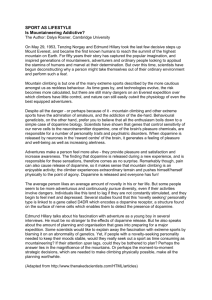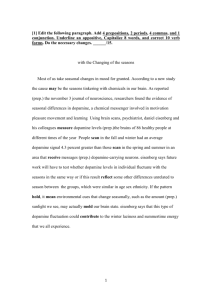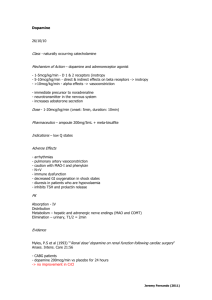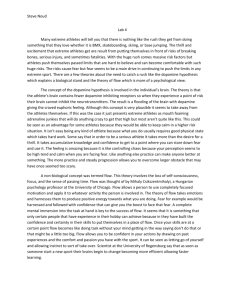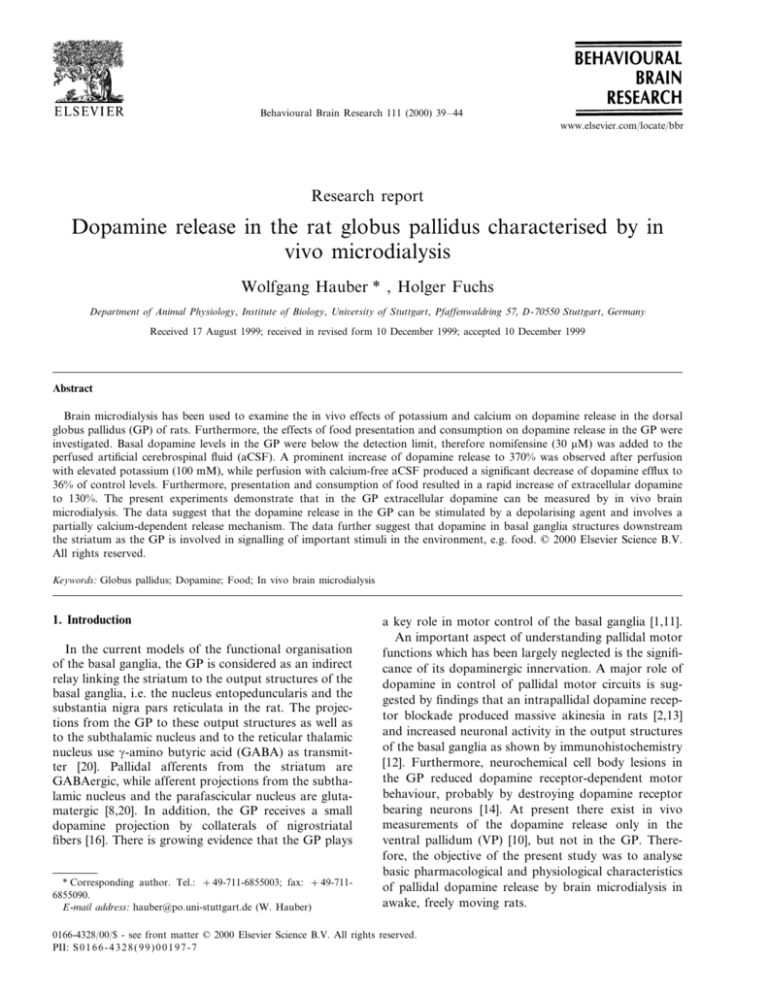
Behavioural Brain Research 111 (2000) 39 – 44
www.elsevier.com/locate/bbr
Research report
Dopamine release in the rat globus pallidus characterised by in
vivo microdialysis
Wolfgang Hauber * , Holger Fuchs
Department of Animal Physiology, Institute of Biology, Uni6ersity of Stuttgart, Pfaffenwaldring 57, D-70550 Stuttgart, Germany
Received 17 August 1999; received in revised form 10 December 1999; accepted 10 December 1999
Abstract
Brain microdialysis has been used to examine the in vivo effects of potassium and calcium on dopamine release in the dorsal
globus pallidus (GP) of rats. Furthermore, the effects of food presentation and consumption on dopamine release in the GP were
investigated. Basal dopamine levels in the GP were below the detection limit, therefore nomifensine (30 mM) was added to the
perfused artificial cerebrospinal fluid (aCSF). A prominent increase of dopamine release to 370% was observed after perfusion
with elevated potassium (100 mM), while perfusion with calcium-free aCSF produced a significant decrease of dopamine efflux to
36% of control levels. Furthermore, presentation and consumption of food resulted in a rapid increase of extracellular dopamine
to 130%. The present experiments demonstrate that in the GP extracellular dopamine can be measured by in vivo brain
microdialysis. The data suggest that the dopamine release in the GP can be stimulated by a depolarising agent and involves a
partially calcium-dependent release mechanism. The data further suggest that dopamine in basal ganglia structures downstream
the striatum as the GP is involved in signalling of important stimuli in the environment, e.g. food. © 2000 Elsevier Science B.V.
All rights reserved.
Keywords: Globus pallidus; Dopamine; Food; In vivo brain microdialysis
1. Introduction
In the current models of the functional organisation
of the basal ganglia, the GP is considered as an indirect
relay linking the striatum to the output structures of the
basal ganglia, i.e. the nucleus entopeduncularis and the
substantia nigra pars reticulata in the rat. The projections from the GP to these output structures as well as
to the subthalamic nucleus and to the reticular thalamic
nucleus use g-amino butyric acid (GABA) as transmitter [20]. Pallidal afferents from the striatum are
GABAergic, while afferent projections from the subthalamic nucleus and the parafascicular nucleus are glutamatergic [8,20]. In addition, the GP receives a small
dopamine projection by collaterals of nigrostriatal
fibers [16]. There is growing evidence that the GP plays
* Corresponding author. Tel.: +49-711-6855003; fax: + 49-7116855090.
E-mail address: hauber@po.uni-stuttgart.de (W. Hauber)
a key role in motor control of the basal ganglia [1,11].
An important aspect of understanding pallidal motor
functions which has been largely neglected is the significance of its dopaminergic innervation. A major role of
dopamine in control of pallidal motor circuits is suggested by findings that an intrapallidal dopamine receptor blockade produced massive akinesia in rats [2,13]
and increased neuronal activity in the output structures
of the basal ganglia as shown by immunohistochemistry
[12]. Furthermore, neurochemical cell body lesions in
the GP reduced dopamine receptor-dependent motor
behaviour, probably by destroying dopamine receptor
bearing neurons [14]. At present there exist in vivo
measurements of the dopamine release only in the
ventral pallidum (VP) [10], but not in the GP. Therefore, the objective of the present study was to analyse
basic pharmacological and physiological characteristics
of pallidal dopamine release by brain microdialysis in
awake, freely moving rats.
0166-4328/00/$ - see front matter © 2000 Elsevier Science B.V. All rights reserved.
PII: S 0 1 6 6 - 4 3 2 8 ( 9 9 ) 0 0 1 9 7 - 7
40
W. Hauber, H. Fuchs / Beha6ioural Brain Research 111 (2000) 39–44
2. Materials and methods
2.1. Subjects
Protocols for animal experiments described in this
study were performed according to the national laws on
animal experiments and were approved by the proper
authorities.
Male Sprague–Dawley rats (Charles River, Germany)
weighing 200–250 g on arrival were housed in groups of
4 – 5 animals in transparent plastic cages (type IV) in a
colony room (temperature: 2192°C; relative humidity:
5595%). Animals were maintained on a 12:12 h light–
dark cycle with lights on at 06:00 h. Food (rodent
maintenance diet, Altromin, Germany) was restricted to
15 g/day and per animal, water was freely available.
2.2. Stereotaxic surgery
Intracranial, silikonized guide cannulae (CMA/12;
outer diameter: 0.9 mm) (CMA, Sweden) were implanted
unilaterally and aimed to the GP. The co-ordinates
relative to bregma were: AP −1.3 mm; L 3.1 mm in
either the right or left GP; V −5.2 mm from dura with
the incisor bar set 3.3 mm below the interaural line [23].
Surgery was performed with a stereotaxic frame (David
Kopf Instruments, USA) using standard stereotaxic
procedures under sodium pentobarbital anaesthesia (60
mg/kg i.p., Sigma, Germany) with atropine sulfate pretreatment (0.5 mg/kg i.p., Sigma, Germany). After
surgery animals were housed individually in Macrolon®
( 37×21×30 cm) cages (type III) with raised solidwalled lids.
2.3. Microdialysis
Microdialysis experiments started at least one week
after surgery and were performed in a plexiglas bowl
(CMA, Sweden). A microdialysis probe (CMA/12, Sweden; 2 mm exposed membrane length, 0.5 mm outer
membrane diameter) was inserted through the guide
cannula and connected via a swivel (Instech, USA) with
a CMA/100 microdialysis pump (CMA, Sweden).
Probes were perfused with aCSF (147 mM Na+, 2.5 mM
K+, 2.2 mM Ca2 + , 0.9 mM Mg2 + , 155.7 mM Cl−) and
30 mM nomifensine [Research Biochemicals Inc., USA]).
For potassium stimulation, aCSF was used with 100 mM
K+ and 47 mM Na+ (rest unchanged). Calcium-free
aCSF was produced by omitting CaCl2. Nomifensine
was added from aliquots of a frozen ( −75°C) stock
solution in aCSF. For calcium-free aCSF, bidestilled
water was used for the stock solution. Perfusion flow
rate was 2.5 ml/min and dialysate samples were collected
every 30 min.
2.4. High pressure liquid chromatography (HPLC)
Dialysates were analysed for dopamine using reversed-phase ion-pair HPLC with electrochemical detection. The mobile phase (pH 3.7) consisted of 60 mM
NaH2PO4, 0.4–0.5 mM octanesulfonic acid, 0.14 mM
EDTA and 15% (v/v) methanol. Sample run time was
B 22 min at a flow of 0.35 or 0.4 ml/min. A Nucleosil
100-5-C18 column (5 mm particles, length×i.d. 125 ×3
mm, Bischoff, Germany) was used combined with a
precolumn (length 20 mm). Electrochemical detection
was performed with a VT-03 electrochemical flow cell
and an INTRO detector (Antec, Netherlands). The
working electrode was set at +800 mV (experiment 1)
and + 600 mV (experiment 2) against an Ag/AgCl
reference electrode. The HPLC apparatus consisted of a
Kontron 520 pump and a Kontron 465 autosampler
(Bio-Tek Kontron, Germany). Data were recorded by a
MT2 Data System (Bio-Tek Kontron, Germany). The
detection limit (signal to noise \ 3) for dopamine was
about 3 pg/injection.
2.5. Experimental procedures
In the first experiment (n= 6), we studied GP dopamine release and the effects of perfusion with elevated
potassium and calcium-free aCSF. The experiment was
carried out between 12:00–02:00 h during constant light.
Four hours after probe insertion, aCSF was changed to
elevated potassium aCSF for 30 min and another 4 h
later the probe was perfused for 2 h with calcium-free
aCSF. In the second experiment (n= 5), we tested the
effects of a physiological stimulus, i.e. food. The experiment was performed during 08:30 and 20:30 h under
constant light. Seven and a half hours after probe
insertion and continuous perfusion with aCSF, standard
food pellets (rodent maintenance diet, Altromin, Germany) were given to 24-h food deprived animals for 30
min.
2.6. Histology
After the experiments, animals were sacrificed by an
overdose of sodium pentobarbital and the brains were
fixed for 2 h in 10% (v/v) formalin and immersed in 30%
(w/v) sucrose. 40 mm sections were taken by a cryostat
(Leica, Germany) and stained with cresyl violet to verify
probe location.
2.7. Statistics
Data are expressed and statistically analysed as follows [29]: all values are expressed as percentages of
controls. The average concentrations of three samples
(deviation B 10%) immediately before perfusion with
elevated potassium aCSF and before presentation of
W. Hauber, H. Fuchs / Beha6ioural Brain Research 111 (2000) 39–44
food were considered as respective control values and
were defined as 100%. Data were analysed (SigmaStat
Vers. 2.0, SPSS Inc., USA) by a nonparametric oneway ANOVA for repeated measurements followed by
Dunnett’s multiple comparisons test. The level of significance was set at P B0.05.
3. Results
Extracellular dopamine levels in the GP were at the
limit of detection (B3 pg/sample) precluding reliable
measurement of the basal release. Therefore, the catecholamine reuptake blocker nomifensine (30 mM) was
added to the perfusate [7,18,24]. Thereafter, basal values of dopamine were reliably detected. For instance,
the mean dopamine level (9SEM) of the last control
sample before food presentation was 40.99 4.3 pg/sample (n=5).
Results of the first experiment demonstrate that perfusion of potassium (100 mM) for 30 min led to a
significant, about 3.7-fold increase in dialysate dopamine content (PB 0.05, n= 6) (Fig. 1A). Furthermore, perfusion with calcium-free aCSF revealed that
dopamine efflux was at least partially calcium-dependent (Fig. 1A): Compared to the control value (T =270
min) immediately preceding the first calcium-free sample, dopamine efflux was significantly reduced during
perfusion with calcium-free aCSF for 120 min (maximally to 36% of the control value) (P B 0.05, n = 6) and
increased immediately after reperfusion with normal
aCSF. A moderate increase of dopamine baseline levels
was observed over the entire microdialysis period of 10
h and dopamine dialysate contents of the last three
samples were significantly higher than the control value
(T= 0 min) (P B0.05, respectively). In the second experiment, we tested the effect of food presentation and
consumption on pallidal dopamine release in 24 h-food
deprived rats. After presentation of food at the beginning of the sample interval, animals (n = 5) which were
inactive or sleeping before, became active and started to
eat within 5–10 min until food was removed at the end
of the sampling period. Extracellular dopamine increased significantly during food consumption (Fig. 1B)
and subsided about 60 min later. As in experiment 1,
there was a moderate increase in the dopamine baseline
levels over the entire microdialysis period. Fig. 2 shows
the location of microdialysis probes of all animals used
in both experiments. Only rats with proper probe location were included in Fig. 2 and in the data evaluation.
4. Discussion
Using in vivo microdialysis in awake, freely moving
rats, the present experiments demonstrate to our
41
knowledge for the first time a partially calcium-dependent dopamine release in the GP which can be increased by perfusion with elevated potassium aCSF or
by an incentive stimulus, i.e. food.
Basal dopamine levels in the GP monitored by microdialysis are relatively low and can not be reliably
measured with an HPLC system with a detection limit
of about 3 pg/injection as already reported earlier [4].
Therefore, we used the catecholamine reuptake blocker
nomifensine to increase dopamine levels as described in
numerous studies (e.g. [7,18,25]). The dose of
nomifensine we used has been shown to produce a
robust increase in extracellular dopamine [18]. There is
consistent evidence that nomifensine does not alter
major pharmacological characteristics of the dopamine
release, i.e. its calcium- and tetrodotoxin-sensitivity [3].
Furthermore, the dopamine release induced by physiological stimuli is comparable whether or not
nomifensine is added to the aCSF (see [7]): For instance, increases of extracellular dopamine levels induced by stress in the prefrontal cortex, or by food
consumption in the nucleus accumbens are similar in
the presence or absence of nomifensine.
Experiment 1 demonstrates that perfusion of the GP
with elevated potassium aCSF induced a significant
increase of dopamine efflux. This finding is in keeping
with the demonstration of a potassium-evoked dopamine release in a slice preparation of the rat GP [27].
The magnitude of the potassium-induced dopamine
increase in the GP is comparable to the striatal or
nigral dopamine release induced by similar concentrations of potassium [6,25]. Thus, dopamine release in the
GP can be elevated by a depolarising stimulus like
potassium which is likely to be mediated by a carrierindependent, presumably vesicular process [6]. Furthermore, removal of calcium from the aCSF produced a
decrease of dialysate dopamine content to 36% of controls which corresponds well with similar findings obtained in the striatum [5,19]. Therefore, it is concluded
that the extracellular dopamine measured in our preparation is largely derived from a calcium-dependent
vesicular process. There was a moderate increase of
baseline dopamine levels in our preparation over the
entire experiment. One explanation could be that because of the continuous local reuptake blockade there is
an accumulation of extracellular dopamine in the GP.
Alternatively, due to the long microdialysis period, this
might reflect increases of extracellular dopamine in the
GP during the light-dark cycle like those described in
the caudate-putamen [21,22]. This question will be addressed in further studies using an HPLC method with
an improved sensitivity in order to perfuse aCSF with
reduced nomifensine concentrations or even without
nomifensine. Finally, we studied the effect of a physiological stimulus known to activate the ascending dopamine systems, i.e. food. The relative increase in
42
W. Hauber, H. Fuchs / Beha6ioural Brain Research 111 (2000) 39–44
extracellular dopamine (130 – 200% of controls) induced
by food has been shown to be particularly prominent in
the nucleus accumbens and prefrontal cortex, but also
in the caudate-putamen [7,28]. Likewise, we observed a
food-induced increase of pallidal dopamine efflux to
about 130% of controls. It is unlikely that the experimental conditions in our study interfere with the foodinduced dopamine release in the GP. The relative
increases induced by feeding are known to be similar,
irrespective whether rats were perfused using aCSF
with or without a dopamine reuptake blocker [28].
Furthermore, dopamine release during food intake experiments seems to be related to the initiation of eating
and not to food-related motor activity [28]. Thus one
may conclude that an incentive stimulus like food does
not only increase dopamine activity in the nucleus
Fig. 1. (A) The effect of perfusing with elevated potassium (100 mM, 30 min) and calcium-free (120 min) aCSF containing nomifensine (30 mM)
on dopamine efflux in the globus pallidus (expressed as percent of basal values 9 SEM). * P B 0.05 versus T= 0 min (filled circle); c PB 0.05
versus T =270 min (filled circle). n= 6. (B) The effect of presentation and consumption of food pellets (30 min) in 24-h food-deprived rats on
dopamine efflux in the globus pallidus (expressed as percent of basal values 9SEM). ACSF contained nomifensine (30 mM). * P B0.05 versus
T=0 min (filled circle). n= 5.
W. Hauber, H. Fuchs / Beha6ioural Brain Research 111 (2000) 39–44
43
Fig. 2. Schematic diagram showing the histologically confirmed location of the probes reconstructed on the basis of serial coronal sections derived
from the atlas of Paxinos and Watson [23]. The positions of the exposed probes of all animals from both experiments were within the shaded
areas. GP, globus pallidus.
accumbens, caudate-putamen or prefrontal cortex [7,28]
but also in the GP. Therefore, the present data provide
evidence that the dopamine innervation of the GP might
share two major characteristics of ascending dopamine
systems: first, a tonic mode of operation which might
serve to enable a wide range of behaviours; second, a
phasic mode of operation which might be related to
signalling of environmental motivating stimuli [26]. Behavioural studies provide evidence in favour of an
enabling function of dopamine in the GP, because a
stimulation of pallidal dopamine receptors increased
locomotor activity [17] and produced stereotyped movements [9], while a blockade induced akinesia in rats [2,13].
Furthermore, massive reductions of dopamine levels in
the lateral GP (the primate homologue to the rat GP) in
parkinsonian patients most likely contribute to hypokinesia in this disease [15].
In summary, the present study shows by in vivo brain
microdialysis that GP dopamine release can be stimulated by a depolarising agent and involves a partially
calcium-dependent release mechanism. Furthermore, GP
dopamine seems to contribute to signalling of important
stimuli in the environment which subserves adaptive
control of behaviour [26] and might, as shown here,
involve basal ganglia structures downstream the striatum.
44
W. Hauber, H. Fuchs / Beha6ioural Brain Research 111 (2000) 39–44
Acknowledgements
The authors thank S. Nitschke for excellent technical
assistance and Drs M.G.P. Feenstra and B.D.
Kretschmer for helpful advice.
References
[1] Chesselet M-F, Delfs JM. Basal ganglia and movement disorders: an update. Trends Neurosci 1996;19:417–22.
[2] Costall B, Naylor RJ, Olley JE. Catalepsy and circling behaviour after intracerebral injections of neuroleptic, cholinergic
and anticholinergic agents into the caudate-putamen, globus
pallidus and substantia nigra of rat brain. Neuropharmacology
1972;11:645 – 63.
[3] Di Chiara G. In-vivo brain dialysis of neurotransmitters.
Trends Pharmacol Sci 1990;11:116.
[4] Drew KL, O’Connor TO, Kehr J, Ungerstedt U. Regional
specific effects of clozapine and haloperidol on GABA and
dopamine release in the basal ganglia. Eur J Pharmacol
1990;187:385 – 97.
[5] Drew KL, O’Connor WT, Kehr J, Ungerstedt U. Characterization of gamma-aminobutyric acid and dopamine overflow
following acute implanation of a microdialysis probe. Life Sci
1989;45:1307 – 17.
[6] Fairbrother IS, Arbuthnott GW, Kelly JS, Butcher SP. In vivo
mechanisms underlying dopamine release from rat nigrostriatal
terminals: II. Studies using potassium and tyramine. J Neurochem 1990;54:1844–51.
[7] Feenstra MGP, Botterblom MHA. Rapid sampling of extracellular dopamine in the rat prefrontal cortex during food consumption, handling and exposure to novelty. Brain Res
1996;742:17 – 24.
[8] Féger J. Updating the functional model of the basal ganglia.
Trends Neurosci 1997;20:152–3.
[9] Fletcher GH, Starr MS. Behavioural evidence for the functionality of D-2 but not D-1 dopamine receptors at multiple brain
sites in the 6-hydroxydopamine-lesioned rat. Eur J Pharmacol
1987;138:407 – 11.
[10] Gong WH, Neill D, Justice JB. 6-Hydroxydopamine lesion of
ventral pallidum blocks acquisition of place preference conditioning to cocaine. Brain Res 1997;754:103–12.
[11] Hauber W. Involvement of basal ganglia transmitter systems
in movement initiation. Progr Neurobiol 1998;56:507–40.
[12] Hauber W, Lutz S. Blockade of dopamine D2, but not of D1
receptors in the rat globus pallidus induced Fos-like immunoreactivity in the caudate-putamen, substantia nigra and
entopeduncular nucleus. Neurosci Lett 1999;271:73–6.
[13] Hauber W, Lutz S. Dopamine D1 or D2 receptor blockade in
the globus pallidus produces akinesia in the rat. Behav Brain
Res 1999;106:143 – 50.
.
[14] Hauber W, Lutz S, Münkle M. The effects of globus palliduslesions on dopamine-dependent motor behaviour in rats. Neuroscience 1998;86:147 – 57.
[15] Hornykiewicz O. Biochemical aspects of parkinson’s disease.
Neurology 1998;51:S2 – 9.
[16] Lindvall O, Björklund A. Dopaminergic innervation of the
globus pallidus by collaterals from the nigrostriatal pathway.
Brain Res 1979;172:169 – 73.
[17] Napier, TC. Transmitter actions and interactions on pallidal
neuronal function. In: Kalivas, PW, Barnes, CD, editors. ‘Limbic Motor Circuits and Neuropsychiatry.’ CRC Boca Raton:
Press Inc., 1993, p. 125 – 153.
[18] Nomikos GG, Damsma G, Wenkstern D, Fibiger HC. In vivo
characterization of locally applied dopamine uptake inhibitors
by striatal microdialysis. Synapse 1990;6:106 – 12.
[19] Osborne PG, O’Connor WT, Ungerstedt U. Effects of varying
the ionic concentration of a microdialysis perfusate on basal
striatal dopamine levels in awake rats. J Neurochem
1991;56:452 – 6.
[20] Parent A, Hazrati L-N. Functional anatomy of the basal ganglia. II. The place of subthalamic nucleus and external pallidum in basal ganglia circuitry. Brain Res Rev
1995;20:128 – 54.
[21] Paulson PE, Robinson TE. Regional differences in the effects
of amphetamine withdrawal on dopamine dynamics in the
striatum. Analysis of circadian patterns using automated online microdialysis. Neuropsychopharmacology 1996;14:325–37.
[22] Paulson PE, Robinson TE. Relationship between circadian
changes in spontaneous motor activity and dorsal versus ventral striatal dopamine neurotransmission assessed with on-line
microdialysis. Behav Neurosci 1994;108:624 – 35.
[23] Paxinos G, Watson C. The Rat Brain in Stereotaxic Coordinates. New York: Academic Press, 1986.
[24] Ripley TL, Jaworski J, Randall PK, Gonzales RA. Repeated
perfusion with elevated potassium in in vivo microdialysis —
a method for detecting small changes in extracellular dopamine. J Neurosci Methods 1997;78:7 – 14.
[25] Robertson GS, Damsma G, Fibiger HC. Characterization of
dopamine release in the substantia nigra by in vivo microdialysis in freely moving rats. J Neurosci 1991;11:2209.
[26] Schultz W. Predictive reward signal of dopamine neurons. J
Neurophysiol 1998;80:1 – 27.
[27] Shindou T, Koizumi S, Kataoka Y, Watanabe S, Yamamoto
K, Nakanishi H. Inhibitory effects of NMDA on dopaminergic transmission in a slice preparation of rat globus pallidus.
Japan J Pharmacol 1992;58:79 – 82.
[28] Westerink BHC. Brain microdialysis and its application for the
study of animal behaviour. Behav Brain Res 1995;70:103.
[29] Westerink BHC, Enrico P, Feimann J, DeVries JB. The pharmacology of mesocortical dopamine neurons: a dual-probe microdialysis study in the ventral tegmental area and prefrontal
cortex of the rat brain. J Pharmacol Exp Ther 1998;285:143–
54.


